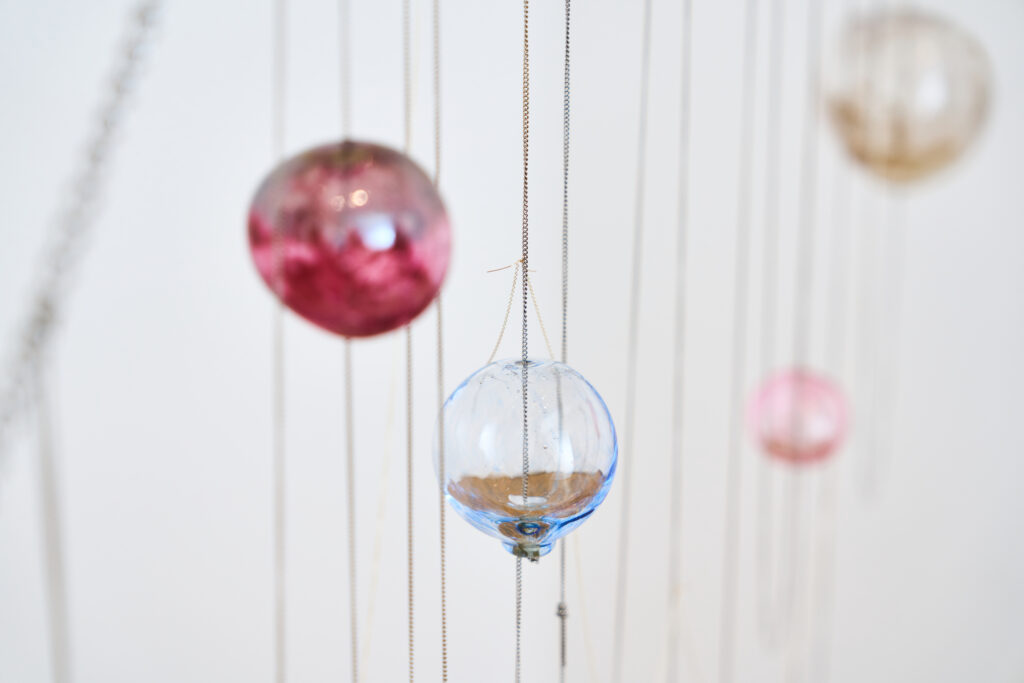
HOUSTON — Jillian Conrad has unveiled her latest works in an exhibition titled “What drawing can be: four responses” at the Menil Drawing Institute. The exhibit, which runs through August 10, 2025, features five new pieces that challenge conventional definitions of drawing, alongside site-specific installations by renowned artists such as Teresita Fernández, Tony Lewis, and Constantin Luser.
Conrad’s installation includes a striking centerpiece titled “Cetus.” This piece, which partially levitates within the gallery space, features colored glass orbs suspended on thin metal chains. Some of these chains are anchored to a chunk of asphalt, while others cascade to the floor, creating a dynamic interplay of shape and form. “Cetus” references the celestial constellation of the same name, connecting to Greek mythology and the historical significance of drawing and mapping.
In the same exhibition, “Cetus” serves not only as an artistic statement but also as a navigational aid, offering viewers a unique lens through which to explore Conrad’s other works. The intricate chain design, made of numerous interlocking loops, is echoed in her piece “Letter.” This work consists of a suspended string net embedded with hand-formed pewter letters that convey the message, “I would gladly spend the night writing to you,” in both English and French. The sculpture embodies a blend of language and space, presenting a delicate balance between the internal and external worlds.
Conrad’s work often reflects a broader narrative, with “Letter” inspired by a collection of lost correspondence from the Seven Years’ War. These letters, written in 1758, represent a tangible connection to history, transforming the act of drawing into a medium that conveys thought and emotion. The original letters, crafted from precious ink and paper, highlight the intrinsic value of communication and its physical manifestations.
The artist emphasizes the dualities present in her work, viewing art as a “reciprocity with the world.” In her installation, she explores the themes of loss and discovery, suggesting that something can be found precisely because it has been lost. Interestingly, the constellation of “Cetus” would have been visible to sailors in the 18th century, creating a poignant link between past and present.
Another notable piece, titled “Fork,” features a rose branch and a small piece of brass. This work adds a layer of absurdity and humor, reflecting Conrad’s affinity for surrealism. As viewers navigate the gallery, the spatial separation between the two elements becomes apparent, prompting a conceptual exploration of imagination and perception. Conrad describes this gap as reminiscent of a branch hidden by a bird’s beak; although obscured, its existence remains unquestioned.
In her artist talk, Conrad elaborated on how “Fork” serves as a framing device for the entire installation. It draws attention to the relationship between observation, contemplation, and creation, inviting viewers to engage with the artwork on a deeper level.
“What drawing can be: four responses” continues to challenge traditional notions of art and invites audiences to reconsider the boundaries of drawing. The exhibition, curated by Edouard Kopp, John R. Eckel, Jr., and Kelly Montana, is a testament to Conrad’s innovative approach and her ability to weave complex narratives through art.
As the exhibition unfolds, visitors to the Menil Drawing Institute will have the opportunity to explore these intricate connections and the evolving dialogue between art and experience.






